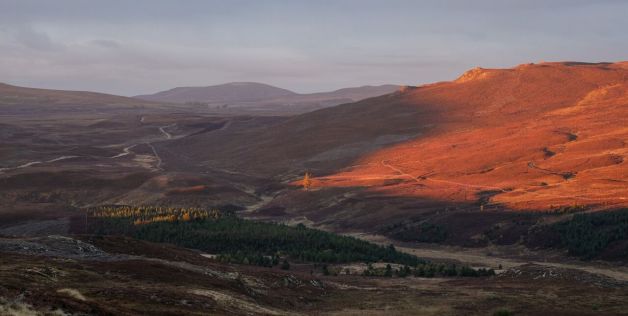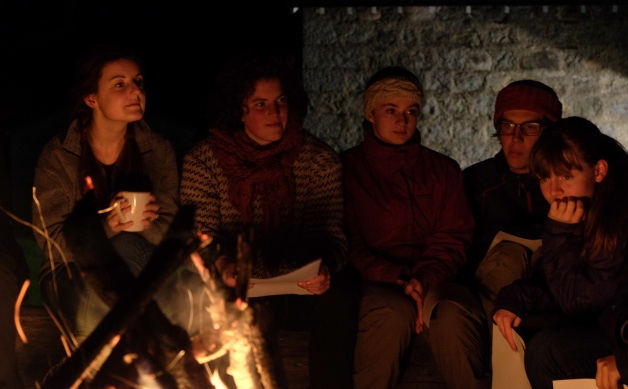When Elizabethans spoke of ‘wilderness’ they envisaged dense, uncultivated woods, home to bandits and fearsome beasts. Shakespeare describes the Forest of Arden as, ‘a desert inaccessible under the shade of melancholy boughs’. A mid-seventeenth-century poetical dictionary includes appropriate epithets for a forest as: ‘dreadful’, ‘gloomy’, ‘wild’, ‘desert’. ‘uncouth’, ‘melancholy’, ‘unpeopled’ and ‘beast-haunted’. The very word ‘savage’ originate from silva – a wood. Untamed highlands were similarity reviled: denounced as obstacles to human progress, synonymous with paganism and death. Hence, the mass felling of the UK’s forests and extirpation of wild animals that ensued in Britain between 1500 and 1700 was widely celebrated by contemporary commentators as a triumph of civilization.
Yet, following the industrial revolution and the birth of Romanticism, this paradigm for wilderness was recast beyond recognition. To the romantics of the 18th and 19th century, by its very contrast with cultivation, wilderness was necessary to give meaning and definition to life; a symbol of human freedom. ‘A wilderness is rich with liberty’ thought Wordsworth, who lamented the encroachment of man unto such lands: ‘Whereso’er the traveller turns his steps, He sees the barren wilderness erased, Or disappearing’. Such visions for nature were also shared by, and directly influenced, the bourgeoning American preservationist movement. For Henry David Thoreau ‘In wilderness [was] the preservation of the world’.
Once despised and allied to Satan, upland landscapes became symbols of God’s beauty. ‘One of the sublimest objects in natural scenery,’ declared Archibald Alison in 1790, ‘is an old and deep wood, covering the side of a mountain’. ‘The further I ascend from animated nature, from men and cattle and the common birds of the woods and the fields’ wrote Coleridge in 1803 after climbing the Cumbria’s Kirkstone Pass in a storm, ‘the greater becomes in me the intensity of the feeling of life… ‘God is everywhere’. To Wordsworth, mountains ‘in the beauty and variety of their surfaces and colours… are surpassed by none’. Importantly, to these voices, the beauty of wilderness, was in its’ absence of man. The uninterrupted moorland and barren outcrops traversing the British uplands were the epitome of this splendour.
But fast forward to the present, and it is those very ‘British’ landscapes that are under attack from a new breed of wilderness disciples. George Monbiot, founder of ‘Rewilding Britain’, claims that ‘Farming has done more extensive damage to wildlife and habitats than all the factories ever built.’ The vacant lands that so inspired Wordsworth are to Monbiot ‘wildlife deserts’…‘one of the most depressing landscapes in Europe.’ For Monbiot, Blake’s ‘dark satanic mills’ are the ‘green and pleasant land’.
Fatefully, it is the Elizabethan concept of wilderness that led to the eager destruction of the forests, which is now revered by many in the contemporary conservation community. Shakespeare’s ‘deserts’, ‘inaccessible under the shade of melancholy boughs’ encapsulate the dreams of the rewilding movement.
In the southern uplands of Scotland, the Borders Forest Trust has bought 3,000 hectares of bare mountainside and planted hundreds of thousands of native trees. A wealthy private individual Paul Lister has planted 800,000 staplings on his 28,000 acre Alladale Estate in the Highlands. Though, it is not just trees that rewilding enthusiasts want to reinstate, they seek the beasts too.
Beavers, boars, bison, eagles, lynx and wolves are amongst the favoured contenders for reintroduction. But for the advocates of rewilding, this process is not just about playing to their naturalist fantasies. They point to numerous artificial and natural reintroductions of such ‘keystone’ species, which have the effect of reinvigorating natural habitats (often suppressed by uncontrolled wild grazing) and restoring important ecological processes. Rewilding would serve to not only to stimulate ecotourism to the Scottish Highlands they argue, but to revive the suffocated ecosystems and the essential services they provide: thus providing benefits to all.
But, the rewilders have been faced with strong opposition. Farmers and grouse moor owners fear loss of income from predation; anglers and fishermen fear the disruptive effects of beavers on water courses; the ramblers oppose any kind of restriction upon their right to roam and recreational users, as well as local inhabitants, fear for their own safety. Like many conflicts in conservation, the costs of such an initiative will likely borne by those living alongside the wildlife, often struggling to make ends meet, and not by the bulk of the supporters of rewilding, who likely only visit Scotland occasionally on holiday.
With these issues in mind, and whilst amongst the ‘wild’ Scottish hills in question, we decided to hold a mock debate on the evening of the first day of the field course. Grouped around the campfire, Lord Augustus Moore (A. V. Moore) chaired a meeting in which all the resident of Aviemore were invited to attend. In small groups, the students each embraced the role of key stakeholders in the proposed plan to rewild Aviemore. One by one, they took the floor to articulate their main arguments, whilst choosing whether to respond to ‘points of information’ from the audience.
A dynamic debate ensued, in which the rewilding enthusiasts, conservationists, anglers, farmers, ramblers, runners and hunters (Lord Moore) all expressed their views. Subsequently, the students were then asked to adopt the role of local residents, who were without direct vested interests in any group. The ‘residents’ were then asked whether they supported or objected to the reintroduction of any of the species discussed (wolf, lynx, beaver, bison, wild boar, great bustard and the sea eagle). Responses were mixed and largely depended on whether the animals would be contained or left to roam free. Betraying their own conservationist inclinations, as a whole the ‘residents’ supported the reintroduction of most species, with the notable exception of the infamous wolf.
Hence, maybe a small remnant of the Elizabethan notion of wilderness does still remain with us after all, if only in the guise of little red riding hood.
By Zac Baynham-Herd (demonstrator and avid A. V. Moore impersonator)
Main reference – Keith Thomas, ‘Man and the Natural World’



Pingback: Conservation in the Cairngorms | Cons. Sci.
Pingback: Rewilding Scotland – The Great Debate of Aviemore | conservationconflict
Reblogged this on conservationconflict.
LikeLike
Reblogged this on The Conservation Generation.
LikeLike
I’m not entirely sure the students betrayed their own conservationist tendencies when asked to portray local residents. When given a role that we accept on some level, people have a tendency to conform to the expectations (aka norms) of the assigned role. So when the students were told to adopt the role of local residents without a vested interest in either group, they may have expressed the views they thought they were supposed to have.
It is also significant that before they were asked to adopt this role, the two main groups (those supportive of rewilding and those against it) had polarized views on species reintroduction. We know from research on Social Categorization Theory (SCT) that when two or more groups are being compared on some domain, they will try to maximize their difference (distinctiveness) on that domain. Thus when a group that favors rewilding is confronted with a group that doesn’t, they will support species reintroduction even more. By the time the students were assigned to the residents without vested interests group, there were already outgroups who were strongly for and against rewilding. Therefore they may have adopted a moderate stance in order to maximize their distinctiveness on the salient domain.
But what your debate did show is that situational forces can override an individual’s normal tendencies. Whether in an attempt to portray their assigned role or in response to group forces, the students gave answers they normally wouldn’t have. You may have stumbled upon an opportunity to examine how social psychological principles might apply to human-wildlife conflict.
LikeLike
Edit: the correct name of the above theory is self-categorization theory, not social categorization theory.
LikeLike
Pingback: Good teaching – student and teacher perspectives from the Conservation Science course – Teaching Matters blog